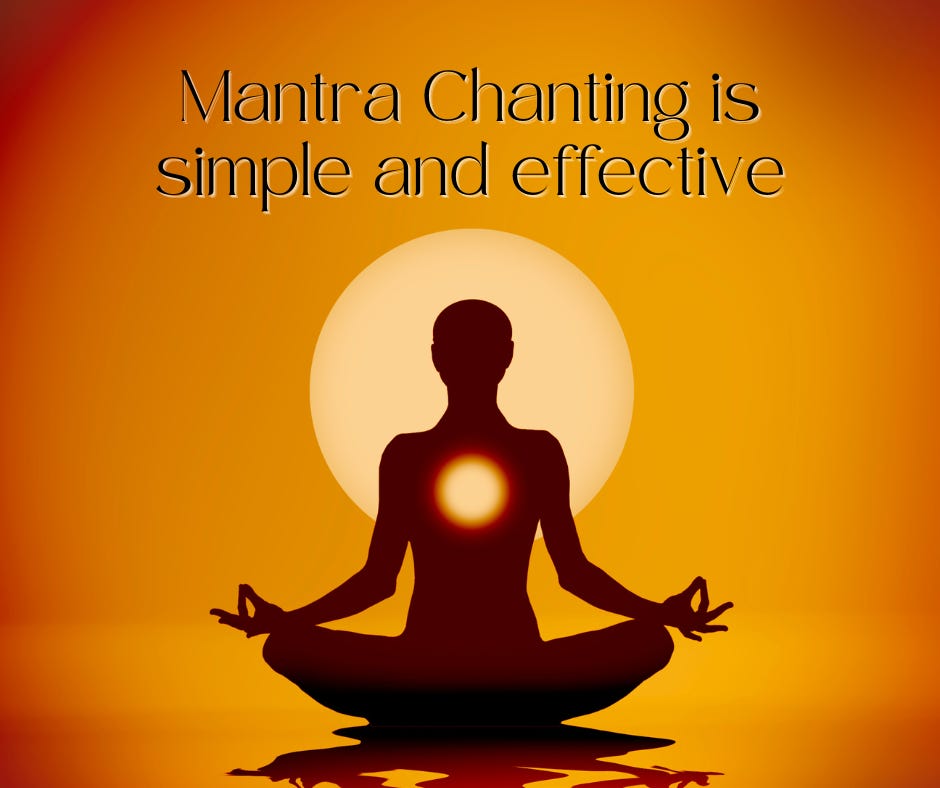Mantra Chanting: 5 Powerful Benefits & Easy Daily Practice
Discover the benefits of mantra chanting and learn 5 simple daily techniques. Calm your mind, boost energy, and realign with ancient spiritual wisdom 🧘🏼
Mantra chanting—Is it difficult? How do we chant mantras effectively? These are common questions that surround this ancient spiritual practice with an air of mystery and complexity. But the truth is, mantra chanting is a simple and transformative form of sacred sound vibration. Let’s explore how this age-old practice can be made accessible to everyone.
Mana is inherent in Mantra: 🧘🏼
Rishi Yaska said – Mantra Mananaat. The word "mantra" is derived from the Sanskrit root "mana dhatu," meaning mind. This highlights that mantra chanting is deeply linked with the mind-body connection. Whether you are listening to or engaging in mantra meditation, it serves as a spiritual practice that directly influences our mental state.
Mantras hold deep significance in remedial astrology. Chanting have been an integral part of Vedic mantras for thousands of years. Most of us have practiced mantra chanting at some point in our lives—whether consciously or not. One of the most recognized examples is the sacred OM or AUM, a sound healing vibration that many of us have chanted, often without realizing its profound benefits. OM chanting benefits include calming the mind and harmonizing the body’s subtle energy much like the Chandra (Soma) Mantra known for enhancing mental clarity and peace.
The ancient Rishis composed mantras for the collective benefit of society, aiming to make mantra chanting a universally accessible spiritual practice. However, over time, the use of these sacred sound vibrations became limited to a select few who were allowed to recite them. This exclusivity led to the loss of ancient wisdom for the broader community. Unfortunately, some individuals misused this knowledge for personal gain—misleading and exploiting the uninformed. As a result, the process of how to chant mantras became clouded in secrecy and confusion.
Most Common Questions About Mantra Chanting Explained 🧘🏼
Let us now address the most frequently asked questions about mantra chanting, including its benefits, timing, posture, and how to chant mantras correctly for the best results.
Q. 1. How to Chant Mantras for Maximum Effectiveness
Ans. How should one chant a mantra for maximum effectiveness? While classical texts do not offer a single, definitive prescription, the effectiveness of mantra chanting largely depends on the devotion and intention we bring to the practice. In mantra chanting, faith plays a crucial role—whether we are silently repeating the mantra or listening to it with full awareness. This sacred sound healing method works best when practiced with sincerity and presence.
Q. 2. What is the best Time to Chant Mantras for Daily Practice? Morning or Evening?
Ans. When is the best time to engage in mantra chanting? For nearly 99% of Vedic mantras, any time of the day is considered auspicious. Although some classical texts recommend specific Ghadis or Prahars, the benefits of mantra chanting are more deeply connected to one's mental state than the actual timing. Many practitioners prefer to begin their mantra chanting early in the morning, feeling refreshed after sleep, while others find peace in evening chanting after daily responsibilities. Ultimately, the timing is a personal choice based on when you feel most centered.
Q. 3. Should I chant several mantras in a day or do I have to chant a single mantra each time?
Ans. Is it necessary to follow specific combinations or sequences while chanting Vedic mantras? Fortunately, there are no rigid restrictions. Vedic mantras can be chanted individually or in meaningful combinations. If a horoscope suggests particular mantras, it’s certainly helpful to follow, but mantra chanting in general offers universal benefits. These sattvik vibrations benefit the mind and spirit regardless of astrological placement. Platforms like the Astro Vedic Remedies YouTube channel provide access to carefully selected mantras suitable for everyone. Each mantra acts as a tool for spiritual practice, aligning subtle energy with specific planets, nakshatras, or Upagrahas - like the Mangal (Marut) Mantra for prosperity—can further enhance targeted benefits.
Q. 4.Is it compulsory to chant the mantra aloud? Can’t I chant them in silence?
Ans. The process of chanting a mantra is known as Japa meditation, and it forms a vital part of traditional mantra chanting. According to the Mantra Shastras, there are different types of Japa—Vaachik, Upanshu, Mansik, Sagarbh, and Agarbh—which depend on whether the mantra is recited aloud, whispered, or repeated mentally with breath control. Rather than getting lost in the technicalities, it's important to remember that even silent chanting can be highly effective. Japa meditation enhances the mind-body connection and fosters spiritual awareness. Focus and faith are the real catalysts—not volume or speed. Avoid chanting mantras mechanically or in haste.
Q. 5. Should we have to chant any mantra for a specific number of days such as 40 days or 51 days ?
Ans. Each repetition in mantra chanting contributes to its cumulative effect, and every recitation holds intrinsic value. It’s a common myth that mantras only show results if practiced for 40, 51, or 108 days. In truth, even a single session of mantra chanting can deliver immediate benefits. Take, for example, a deep breath followed by the resonant sound of OM—a practice central to OM chanting benefits. This simple act can instantly generate calmness, mental clarity, and subtle energy alignment within moments.
Q.6.How to chant a mantra the correct way? Would there be any harm if I am not able to pronounce the mantra correctly?
Ans. The devotion and intention behind mantra chanting are far more important than the precise method of recitation. The Sam Veda presents various techniques for how to chant mantras, yet many mantras are considered self-correcting—their pronunciation improves naturally with continued practice. Classical texts do stress the importance of Akshar Shuddhi, Matra Shuddhi, and Swara Shuddhi, especially in formal Vedic mantras. However, from the perspective of spiritual practice, it is one's Shraddha (faith) and presence of mind that amplify the real benefits of mantra chanting over technical perfection.
Mantra Chanting Is Like Growing Rice: A Simple Analogy
Let me explain this using an analogy of rice production and consumption. A farmer must understand the techniques and technical nuances to cultivate rice effectively. Without the correct process, there is no harvest. However, the consumer of rice doesn’t need to know how it was grown to benefit from eating it. Similarly, while a dedicated sadhaka engaging in Vedic mantras and spiritual sadhana must follow a disciplined path, the everyday practitioner of mantra chanting need not adhere to such rigorous methods. For them, mantra chanting remains a powerful spiritual practice that works even without full mastery of formal techniques.
Therefore, approach mantra chanting without fear, doubt, or insecurity. These sattvik sound vibrations were gifted by the great sages, rooted in ancient wisdom and created with divine love for the upliftment of humanity. Even if the effects are not immediately noticeable, the spiritual practice of mantra chanting will never cause harm. On the contrary, it supports subtle energy balance and inner peace over time.
Q. 9. What is the correct posture for chanting mantra? Can I lie down while chanting a mantra?
Ans. You can practice mantra chanting in any posture that feels most natural—whether sitting, lying down, or standing. The key is physical comfort. While some ancient teachings recommend keeping the spine aligned to facilitate Kundalini awakening, this process typically occurs only in advanced stages of deep meditation through dedicated spiritual sadhana. For most practitioners, mantra chanting works by stimulating neural pathways and enhancing the mind-body connection. The more relaxed your body is, the more effective this spiritual practice becomes.
Q. 10. Would it suffice to only listen to the mantra rather than chanting it?
Ans. Yes, some remedial mantras—such as the complex Nakshatra Sutrams—can be challenging to recite and may require dedicated effort to master. However, the practice of chanting with these mantras can still be simple and deeply effective. By playing the mantra in the background and allowing it to serve as a form of sound healing, you can gently observe your thoughts and insert positive auto-suggestions. These suggestions often reach the unconscious mind more effectively during such sessions. Whether you're shaving, bathing, driving, or cooking, background mantra chanting integrates effortlessly into daily life. This type of spiritual practice has shown promising results, even among beginners, especially for those seeking relief from stress or anxiety through mantras.
A Simple 5-Step Procedure to Begin Daily Mantra Chanting 🧘🏼
For those interested in how to chant mantras using a simple, structured approach, the process need not be complicated. Our intention here is not to attain Mantra Siddhi, which requires deep renunciation and long-term spiritual sadhana. Instead, we focus on the benefits of mantra chanting as a practical form of Japa meditation. In today’s fast-paced world, it’s essential to embrace techniques that are both effective and time-efficient. Drawing on my experience with hundreds of horoscopes and guided practices, I humbly suggest the following easy steps to incorporate this spiritual practice into your daily life:
Choose a comfortable position—sitting, lying down, or standing. Begin your mantra chanting by playing the intended mantra softly in the background.
As the sound healing vibration begins, take three to four deep, steady breaths to calm your nervous system and initiate focus.
Gently bring your attention to the mantra’s text and try to read it with mindful focus as best as you can. This refocusing process supports steadying the mind, similar to how the Medha Suktam enhances concentration and cognition. Begin with at least three minutes of steady practice. As you build consistency, extend the session to suit your available time and comfort.
After the session, sit quietly and take a few deep breaths in silence, letting the effects settle.
Let the mantra continue playing in the background for a few more minutes, helping align your subtle energy and ease you gently into your daily routine.
Conclusion: 🧘🏼
For all practical purposes, this simple approach to mantra chanting is more than sufficient. There’s no need for overly complex rituals or rigid rules. These sattvik sacred sound vibrations are divine tools for spiritual upliftment and transformation. For centuries, Vedic mantras have played a central role in remedial astrology and spiritual practice. Our goal should be to make this ancient wisdom available to as many seekers as possible. The great sages who gifted these mantras did so with clarity, love, and deep intent for collective growth. It’s time we demystify how to chant mantras and embrace their benefits with openness and sincerity.
For those concerned about pronunciation errors in mantra chanting, the sages offer a powerful solution: the Saraswati Mantra.. This mantra invokes Goddess Saraswati, who governs speech and learning, and is said to correct pronunciation inaccuracies in Vedic mantras. Even reciting OM before any mantra can purify intent and prepare the mind.
Let’s take the next 40 seconds to immerse ourselves in the divine resonance of the Saraswati Mantra. 🧘🏼🙏




